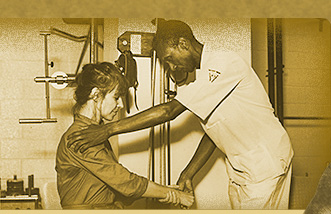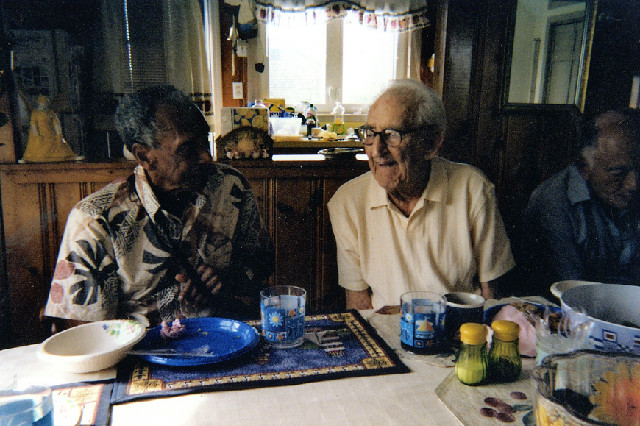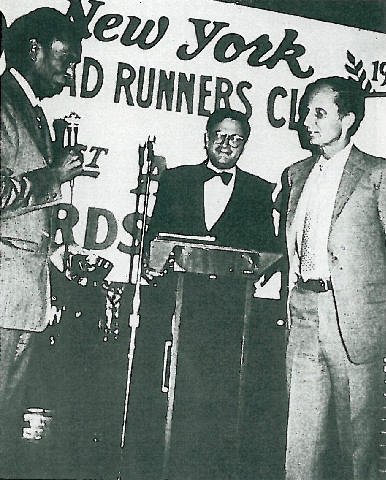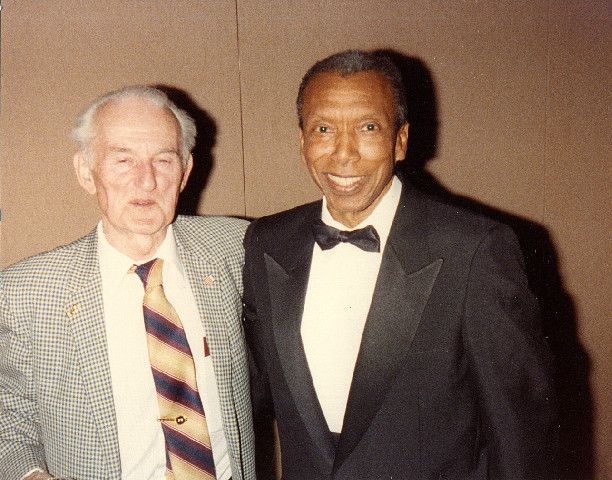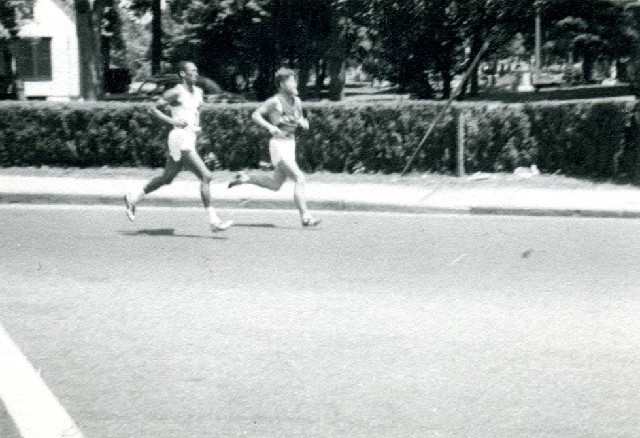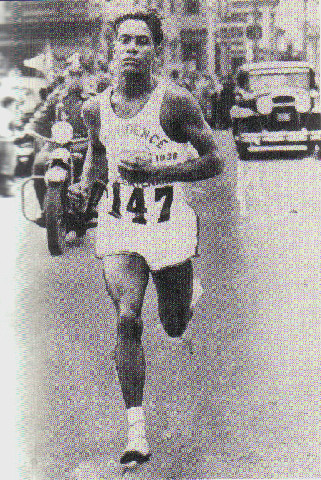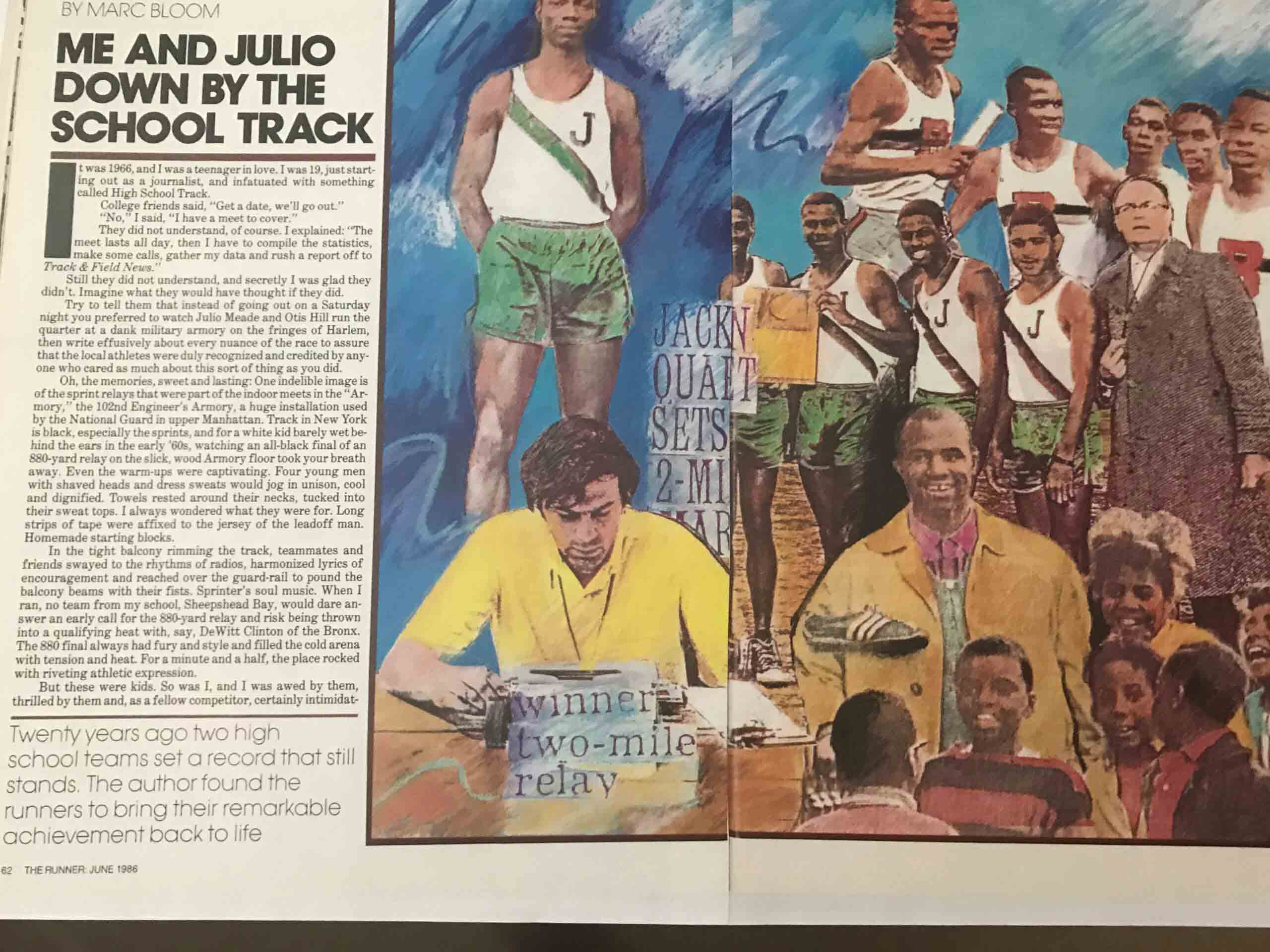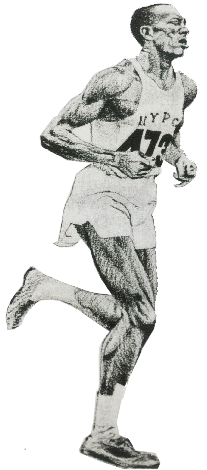
Running History Milestones
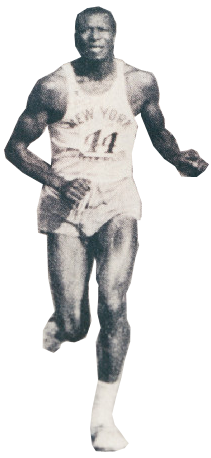
Marc Bloom's Classic Article About the Historic New York City High School 2 Mile Relay Race in 1966 By Marc Bloom
On June 7, 1966, two New York City teams--Boys High of Brooklyn and Andrew Jackson of Queens--shattered the national high school record for the two-mile relay by running to a virtual dead heat in 7:35.6, a race many consider among the greatest, if not the greatest ever run. Jackson was declared the winner, as both schools were given the same time, on the level of what many leading college teams were running then. As a budding journalist of 19 present that Wednesday afternoon at the St. John's University track (I was a one-man press corps that day), I knew the athletes and two coaches well and had a role in staging the event. All of the athletes, and one of the two coaches, was Black. The race, among so many that season of special note, found a place in my heart and propelled my interest in what would become a 56-year track writing career. It also highlighted the breakthrough of young Black athletes in the middle-distances; many of the youngsters excelled in the mile, two-mile and cross-country as well. In June, 1986, on the 20th anniversary of the record (it took 35 years for the record to come down, in 2001), I was editor of The Runner magazine and published a 16,000-word story that brought the historic event back to life. I'd spent months locating the athletes and coaches and conducting numerous interviews in my research. It was a labor of love, and the response was extraordinary. The magazine was inundated with hundreds of letters of appreciation, and to this day people still come up to me at meets wanting to discuss the race and story. In 2016, I helped organize a 50th anniversary celebration at Coogan's restaurant near the Armory track center in upper Manhattan. The place was packed with luminaries, memories were shared and the surviving protagonists feted.
None of The Runner articles (we published from 1978 to 1987; my longtime friend and colleague George Hirsch was founder and publisher), as far as I know, are on-line. With the event's 55th anniversary coming up on June 7, 2021, I wanted to try and give the story a wider audience and asked Gary Corbitt if he would like to post it on his "Ted Corbitt" website www.tedcorbitt.com, which I considered an ideal platform on which to honor athletes and coaches who have meant so much historically to the track community, and to me personally. Gary welcomed the idea, and so the story appears at this link... https://drive.google.com/file/d/1IIrD27eO5kJV1qPDf2HM8wm6tpRx67zz/view?usp=sharing
The Pioneers of Long Distance Running
Browning Ross (1924 – 1998) The Father of American Distance Running
Ted Corbitt is often given this title. I prefer referring to him as one of “The Founding Fathers of American Distance Running.” Browning and Ted were humble kindred spirits who would have no care or interest about such a title. Ross was most important in developing the organizational structure of long distance running in the United States. Ted Corbitt wrote the following about “Brownie.”
“Browning Ross died April 27, 1998.
Ross was an Olympic Steeplechaser in 1948 and 1952.
Ross exceled on the track, cross-country, and roads, winning numerous national running titles.
He ran several marathons (but did not train for them, and never had a shot at showing his real potentials for the event).
Contributions:
- Ross published THE LONG DISTANCE LOG, including all road race results from the USA and elsewhere. Played a role in the build-up of long distance running leading to the running boom.
- Ross introduced the Road Runners Club (RRC) concept to the Middle Atlantic area in 1957 and to the nation in 1958. He helped get the RRC movement off the ground and he served as the first president of the RRCA.
- Ross displeased the Amateur Athletic Union (AAU) for permitting a female to run in a distance race. He put on low key long distance races in his area until the week that he died. This was done year round.
Joe Henderson wrote in his newsletter that had Ross not organized the RRC, someone else would have. I disagree, but when I asked four runners what they felt about the statement, two agreed with Henderson. There were few volunteers around in those days. As for the first four presidents of the RRCA: Ross, Dick Donahue, T.Corbitt and John Sterner: none of them really wanted the job and all escaped at the earliest opportunity.
There is a possibility that there would have been a few local race promotional organizations set up to accommodate the emerging running boom but their missions would not have been as extensive as was that of the RRC. Ross’s starting the RRC movement set the stage and provided a platform for other runners to change the running scene via rules changes for more races, a greater variety of races, giving women and youngsters a chance to run formally, more runner friendly rules, etc. Ross made a difference.”
John Jewell (1912-2001) Road Runners Club of England The Pioneer of Modern Course Measurement
By Ted Corbitt – November 2001
The idea leading to the formation of Road Runners Club of America (RRCA) was imported from England in late 1957 by U.S. Olympic Steeplechaser and a sensational national road running champion Browning Ross, in the Philadelphia area. Ernest Neville and John Jewell (Road Runner Club in England) founding members were the contacts for Americans interested in the workings of the RRC movement.
Long distance runners owe John Jewell a retrospective vote of thanks. He gave Americans two important gifts, boons that contributed greatly to the emerging running boom in the USA. The gifts included sharing the concept and workings of the RRC which had the goal of encouraging active road runners to get involved in promoting their sport, and of serving as advocated for long distance runners.
Active American road runners then infiltrated committees locally and nationally of the sport’s governing body the Amateur Athletic Union (AAU). Parallel committee work on the part of the RRCA was icing on the cake, and this effort led to many rule changes and practices and the sport evolved into the running scene we have today involving both males and females who have an urge run.
A second gift of John Jewell was his sharing with Ted Corbitt, former President of the RRCA the details of the Calibrated Bicycle Method of Measuring road running courses. That method became the cornerstone of the accurate race course measuring program in the USA and elsewhere around the world, gaining acceptability by the governing bodies of our sport. The RRCA led in this accurate course measuring program, quickly followed by a parallel program by the National AAU. Those two measuring programs were merged later and that evolved over the years to become a great source in promoting more accurate course measuring around the world.
Leonard “Buddy” Edelen (1937 – 1997) An American World Record Holder in the Marathon
The greatest marathon performance I ever witnessed was May 24, 1964 Yonkers Marathon. This was the first of two Olympic Marathon trial races. The race started at 12n with the temperature at 91 degrees and high humidity. The Yonkers, New York course was considered the toughest in the United States. On this day Buddy Edelen won by an astounding 20 minutes with in a time of 2:24:25. Ted Corbitt was 12th in his slowest time (3:20:32) at this point in his racing career.
In 1963, Buddy Edelen won Britain’s Polytechnic Marathon in 2:14:28, a world record by 48 seconds. He held ten American long distance running records between 1960 and 1964. A 1980 New York Times articles raised this question to Buddy -how does Buddy Edelen regard his role in marathon history?
“I was the best in the world. I put the marathon on the map in the United States. I was a pioneer.”
Alain Mimoun, 1956 Olympic Marathon Champion, Dies at 92 French runner was often in the shadow of Emil Zatopek.
By
Peter Gambaccini;
June 28, 2013
Alain Mimoun of France, who won the 1956 Olympic marathon in Melbourne after being a silver medalist behind Emil Zatopek in three track races, has died at the age of 92.
Revered as he is, Mimoun would be celebrated as one of the greatest distance runners of all time if not for the presence of Zatopek. The Czech runner relegated Mimoun to second place in the 10,000 at the 1948 London Olympics and to second twice more in the 5000 and 10,000 in Helsinki in 1952.
Finally, Mimoun was able to take gold at age 35 in 2:25:00 in front of 110,000 people in a stadium finish in Melbourne. He awaited Zatopek, who’d won the marathon in 1952 but was sixth this time. The two men embraced, a moment that Mimoun would call “better than the medal.” Mimoun had been well-prepared for racing 26.2 miles. "I gorged myself on 40-K a day for two years, without telling a soul," he told a biographer, Pat Butcher.
Mimoun was born in French Algeria (before Algeria’s 1962 independence) and suffered a serious leg injury at the Battle of Monte Cassino in the Second World War. Indeed, he might have lost part of his left leg through amputation if a storm hadn't destroyed the French field hospital.
He was still winning French national championships at age 45, and he ran a 2:34:36 marathon at age 51. Mimoun was a four-time winner of the international cross country championships, the precursor of the current world championships.
The Associated Press quotes Michel Jazy, who would later become a world record holder in the mile and testified to Mimoun’s diligence and intensity. The two were Olympic roommates, and Mimoun “woke me at 5:30 in the morning to go run, and in the evening he made me go to bed at 8:30,” recalled Jazy. “Even though we were at the Olympics I couldn't go to any of the parties.”
As seen above, in 2004, at age of 83, Mimoun ran with the Olympic Torch through the streets of Paris, on a stage of its journey to Athens.
America’s Original Running Couple Chris & Gordon McKenzie
Chris and Gordon McKenzie were married in 1955. During this era, women’s running was totally ignored by American officials. Females couldn’t compete in competition at distances beyond 220 yards. Today where running couples are very common, this was not the case in the 1950s and 1960s. Chris was English born and was an accomplished record setting runner. She was true pioneer in breaking barriers for the sport of running we enjoy today. Chris competed in the seminal 1961 Manchester Road Race in which she along with Julia Chase Brand and Dianne Lechausse became the first women in the U.S. to participate in a major distance road race.
There were other running couples in the U.S. during this era including Ann and Nat Cirulnick in New York; Lynn and Bob Carmen in California; Sarah and Larry Berman in New England. In field events there was Olga and Harold Connolly.
Ted Vogel – 1948 Olympian Represented the first generation of track runners who moved into road running and changed the sport.
Ted Vogel along with Charley Robbins, Tommy Crane, Bob Black, Clayton Farrar and Lou Gregory, represented the first generation of track runners who moved into road running and changed the sport. This was a transformational point in the history or long distance running.
Ted at age 89 lives in Dover, New Hampshire with his wife Jean. Ted is the oldest living U.S. Olympic marathoner. He placed 14th at the 1948 Olympic Marathon in London. He was national champion at 10,000 meters on the track in 1945, and in the marathon for 1947 at Yonkers. Ted finished in the top 3 twice at the Boston Marathon (3rd in 1947 and 2nd in 1948). In the 1948 Boston Marathon, he was a mere 42 seconds behind the winner Gerald Cote.
Upon graduation from Tufts University in 1949, Ted retired from competitive running at age 23 to raise a family. He competed with all the greats from the 1930s and 1940s; Clarence DeMar, Tarzan Brown, Les Pawson, Old John Kelley, Gerald Cote, Charley Robbins, Bob Black, Gil Dodds, Greg Rice,
and Gunder Hagg.
Other Ted Vogel Highlights:
The youngest runner at age 22 and the first time a college runner won the national U.S. Marathon championship
Record holder at Presentation Club Handicap 10 Miler breaking a legendary record held by Les Pawson and Tarzan Brown.
Winner of the Manchester Thanksgiving Race in 1948, just missing Joe McCluskey’s record by one second.
Trained with Herb McKenley and Gil Dodd under the legendary Coach Jack Ryder BAA and Boston College.
Was mentored by Johnny Semple, Old John Kelley, and Charley Robbins.
Best track times at Tuft’s for 1 mile was 4:23. His 2 mile best was 9:12 indoors against his arch rival Bob Black of the University of Rhode Island.
Placed second to Victor Dyrgall in the National 15K Championship in 1948.
Gary Corbitt
December 21, 2014
Joseph “Joe” Kleinerman – 1912 – 2003
Joe bridged many eras of running starting with the 1925 Millrose Games where he was introduced to the sport. His longevity actively serving running is unparalled as an athlete, coach, race director, race promoter, and administrator. Joe was involved and helped to lead all the growth development areas of running including, age group competition, women’s entry into racing, ultramarathons, and the growing in number of race participants.
Paul Fetscher said the following: “Fred Lebow was the impresario the sport needed. Joe however was the backbone and was always there to make sure the logistics worked.” Ted Corbitt says “Joe Kleinerman has spent more time promoting road races than any other person in world history.” In looking back Joe was one of my favorite people. He was at all the races be it on the track, cross-country or road; his love and care for the people in the sport was very apparent.
Ted Corbitt wrote this tribute at his passing
Remembering Joe Kleinerman
I first saw Joe Kleinerman in the 1947 Junior National AAU and Open 25-Kilometer Championship, held in Milburn, NJ. Many of the top runners in the East were in this early post World War 11 event.
I rated Joe as a good guy, a good friend to have, but short on patience and apparently grouchy at times. He had a great humanitarian heart.
As a runner, Joe was best at distances below 30 Kilometers, but he was a successful marathoner. He was best when he was running out front of the pack.
Joe Kleinerman’s biggest disappointment as a runner was not winning a Senior Metropolitan long distance running championship. During his best days, his own club the Millrose A.A. usually had a superstar on its roster, and superstars do not lose races to teammates.
The late John Sterner of the New York Pioneer Club (NYPC) and Joe Kleinerman were the only New York City runners who bothered to attend the February 1958 convention, arranged by Olympic steeplechaser H. Browning Ross. The event was held in Manhattan to promote the formation of Road Runners Clubs throughout the USA.
John Sterner followed up on the idea, and began the lonely job of trying to persuade local runners to join this emerging club for roadrunners. The NYPC had the biggest roster among the local clubs at the time, and Sterner began recruiting them. Joe was probably the first non-Pioneer Club member to support the idea and joined the (proposed) New York Road Runners Club. Joe was elected Vice-President of this new RRC in 1958. In time, he became proud, because of his role in the club’s survival and in its successful pursuit of its mission.
Joe Kleinerman was unique in that during the era of shortage of road races in New York area that he set up some practices road races in the Bronx. Some of these races were real in every sense and respect, except that they were not official nor the prizes.
Joe Kleinerman gave more of himself to promote long distance running than any of the rest of us would consider doing under any voluntary circumstances.
I would like to commend the dedicated staff of the NYRR for making this final transition for Joe Kleinerman as easy as possible.
November 14, 2003
John J. Kelley: 1930 - 2011 Jacintha “Jess” Kelley: 1931-2003The Greatest American Distance Runner of his Era
His running abilities were evident early. In 1948 he won the National Junior 25K championship as a tenth grader. He went on to become the nation’s top high school miler in 1950 in New London, Conn. IC4A Cross-Country Champion while at Boston University in 1953. He finished 2nd to Wes Santee in NCAA Cross-Country championship race later that year. His 1957 Boston Marathon win was epic and he would be runner-up at Boston on five occasions. He represented the U.S. at the 1956 and 1960 Olympics in the marathon.
Young John Kelley’s most competitive road running years were 1956 to 1963 when he won eight consecutive National Marathon Championships races at Yonkers. I saw each of these Yonkers wins from ages 5 to 12. I was a fan of road running & track & field and followed the sport with the same intensity as my favorite baseball teams; New York Yankees and Cincinnati Reds. John J. Kelley was by far the most dominant long distance runner I ever witnessed. But he was more than a great runner to quote Julia Chase Brand: “he was also just a wonderful, warm, funny, kind human being and a beautiful distance runner.”
I debated on how to title this piece. “America’s All-Time Greatest Long Distance Runner” was considered. To single out one person as the all-time best is difficult and unnecessary. A better comparison is to look at the history of any discipline by era. I often think back how tough and fast these athletes were. How would you like to run a marathon without any or very few water stops? How about running the national championship Yonkers Marathon on a hilly course just four weeks after battling through the Newton Hills and the Boston Marathon? At the 1963 Yonkers Marathon if you did 4:00:00 you were the last finisher among the 76 who completed the distance that day. Eighty percent of the Yonkers finishers were under 3:30, and 39% were under 3 hours in 1963. If we apply these time standards to the 2013 NYC Marathon, over 19,000 runners would be under 3 hours. In this era approximately 2.5% run sub 3 hour marathons.
Young John Kelley met Old John Kelley after a disappointing 1947 race. He was just 16 years old, and John A. Kelley was 40; two time Olympian, twice Boston Marathon champion, and all-time great. Often times people thought they were father and son hence the designation “The Younger” and “The Elder.” Amby Burfoot was inspired by Young Kelley in 1962 after his first high school cross-country race in which his first thought was that he’d never run again. The Old Kelley to Young Kelley to Amby Burfoot connections is quite special. Young John’s 1957 Boston win was first American to win since Old John’s 1945 race, and Amby’s 1968 win was the first for an American since 1957. Bill Rodgers in turn was inspired by Amby’s 1968 win. Bill and Amby were roommate and teammate at Wesleyan University. Bill Rodgers went on to win at Boston four times 1975, 1978 – 1980. Also the inspiration and support that John Kelley and George Terry provided for Julia Chase Brand should be noted. Julia competed in the 1961 Manchester Race along with Chris McKenzie, and Dianne Lechausse. This was a landmark moment in long distance running as women for the first time competed with men in a road race.
Young John represented the first generation of college trained track athletes who moved into road running. This was led by Charley Robbins, Ted Vogel, Browning Ross and followed by George Terry, Young Kelley, Gordon McKenzie, and Hal Higdon. This was the start of a sea change in our sport. Jock Semple says “before Johnny there were only us plodders.” Always in photos encouraging Kelley during or after races is Jock Semple. Jock finished in the top 10 at Boston nine times during the 1930s and 1940s. Jock was the Boston Athletic Association coach and a trainer for the Boston Celtics.
John Kelley’s legacy of being a kind soul who inspired many is shared with his wife Jess. In reading how their house was open to all is a beautiful story of community building at 415 Pequot Avenue – Mystic, Connecticut.
He was inducted into the Road Runners Club of America Hall of Fame in 1971 and the Distance Running Hall of Fame in 2002. John ended his 2002 three minute acceptance speech with the following poetry from Charles Hamilton Sorley:
The rain is on our lips,
We do not run for prize.
But the storm the water whips
And the wave howls to the skies.
The winds arise and strike it
And scatter it like sand,
And we run because we like it
Through the broad bright land.
“The Man Who Taught Me Everything” by Amby Burfoot states - The poem expresses, Kelly says, “the feeling of oneness and humble place” that he always found in running.
A statue of John J. Kelley and his dog Brutus is being unveiled Sunday, September 21, 2014 in Mystic Connecticut.
Gary Corbitt
September 20, 2014
Gordon McKenzie 1927 – 2013“The Consummate Front Runner”
One of America’s greatest runners Gordon McKenzie passed on Friday, July 19th. Gordon’s range of athletic achievements was phenomenal. He competed at a world class level from one mile to the marathon.
Early in his career he had visions of a sub 4 minute mile, and was influenced by the Swedish runners Gunder Hagg, Arne Anderson, and American Gil Dodds. These were the preeminent milers of the 1940s. In 1953 he placed 4th in the Millrose Wannamaker Mile in 4:12.9 after setting the pace. His tendency to be a front runner stemmed from his desire to always achieve personal best times instead of just going for the win. He always competed with a watch and termed himself a pace runner with a time goal in mind for each race. Gordon was a student of the sport seeking out literature on how the Europeans trained. He felt the Europeans were way ahead of the Americans in both training and racing methods.
Gordon was a two time Olympian 1956 (10K) and 1960 (Marathon). He was in the famous 1956 Olympic 10,000 meters battle between Vladimir Kuts and Gordon Pirie. He was U.S. AAU Cross-Country Champion in 1953 a race that featured the Ashenfelter brothers and Browning Ross. In the 1956 he set American Records at 6 miles (29:18.6) and 10K (30:23).
He moved up to the marathon in 1960 and pushed John J. Kelly to a course record during their classic duel in the Olympic Marathon trial race at Yonkers. He was second at the Boston Marathon in 1960 in a time of 2:22:18. Ted Corbitt felt his teammate had the potential to run a 2:15 world record time in the marathon.
Gordon represented the racially integrated New York Pioneer Club (NYPC) his entire running career. He wanted to join the New York Athletic Club (NYAC) who had all the top milers in the country, but wasn’t welcomed due to his inexperience. On the other hand, NYPC welcomed all runners of all abilities. Once Gordon became a top runner, the NYAC approached him about joining, but he declined due to their policies of segregation against Blacks and Jews, choosing instead to stay with the NYPC as a statement of how the sport and society should be. Gordon loved the camaraderie and democracy of the NYPC. He cited Coach Joe Yancey as a gentleman with an engaging personality.
In the early 1960s, Gordon with his engineering background was helpful to John Sterner and Ted Corbitt in their efforts to develop a system of accurately measuring road race courses in the United States.
Gordon credits his wife Christine (Chris) with his many successes. She inspired him in training and racing. Chris was an accomplished runner on the track in the 1950s. She was part of a British team Selsonia Ladies AC that set a world record in the 3 X 880 Yard Relay. Chris competed in the seminal 1961 Manchester Road Race in which Julia Chase Brand and Dianne Lechausse became the first women in the United States to participate in a major distance road race.
May the McKenzie Family cherish and draw strength from their many loving memories of Gordon. To Chris, Tina, Adam, and Stuart my thoughts and prayers are always with you.
Gary Corbitt
July 2013
To learn more running history, visit www.tedcorbitt.com and “like” Ted Corbitt-Pioneer on Facebook.
